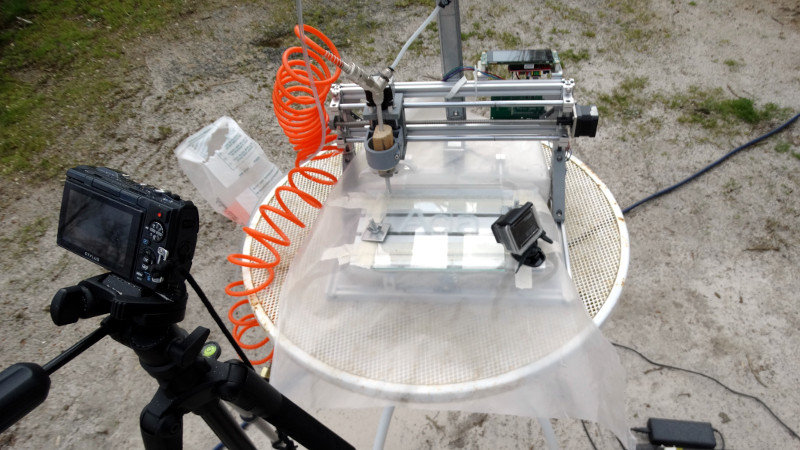CNC machinery, once a piece of workshop exotica, has become such a staple of projects within our sphere as to have become relatively unremarkable. A decent 3D printer can be had without mortgaging a small country, and the honor roll of CNC router builders is long and distinguished. But there is still plenty to surprise us in CNC, and [Fabien Chouteau]’s project shows us this with surprising simplicity. He’s eschewed a router or extruder, and instead fit an off-the-shelf CNC machine kit with a sandblaster.
If you are used to a sandblaster as a means for removing rust from pieces of your motor vehicle, then it’s fair to say that this one isn’t of that ilk. Instead, it’s used in the manner of an engraver, to sandblast a pattern or text onto a surface. This is something he shows us in the video below the break, with a piece of metal and a sheet of glass.The sandblaster itself features a 1.5-litre soda bottle and is driven by an airline.
On the electronic side, he replaced the controller that came with the kit with an STM32F469 discovery board and an Arduino CNC shield. He has a G-code controller from a previous project, to which he’s added a board with a touch screen to create a simple control interface.
This is by no means the only sandblaster we’ve featured, if your interests lie in that direction we can show you everything from the simple to the extreme.
















Awesome, I haven’t thought before about integrating a sand blaster into a CNC system (I think more tool/plasma/laser/water jet cutting or 3D printing ops). With some flow control fine tuning to refine the dot size based on movement I’m confident the system potential can result in some higher detail works. I’m guessing the system has a minimum dot size limit also based on the blasting media. I haven’t sand blasted before though is on the investment list and to do list. Any idea on size limits and maybe an attentuator/solenoid to control the air flow?
Nice way to ruin your CNC machine. Also i’d put solenoid valve to air line.
yeah, that or the media feeder. blasting while raising and lowering the Z axis is killing it.
Care to enlighten me with that?
I’m in no way a home machine shop owner, nor have I worked with a CNC machine ever. But it’s interesting to gather knowledge. So why would that ruin the machine? Will it ruin it due to the higher resistance from the blasting stream? Or anything else?
It’s the CNC equivalent of putting sand in your fuel tank…. fine particles of abrasive do not mix well with linear bearings and feed screws.
Ah okay. I get it. It’s more about wear and tear of the machine itself due to flying particles. But gegnerally speaking – if you isolate your machine properly from the abrasive, you shouldn’t have any negative impacts, right? So basically it doesn’t matter if I slap a water cutter, sand blaster, Plasma cutter, laser cutter or toolbit on the front end as long as my machine itself is properly shielded from whatever fromes out in front of it.
I wonder how much the mechanics will last…
I am speechless
This seems ideal for setting on its side. A larger format can be had in less space, and waste materials just fall away.
Try a painter’s tape mask to sharpen up the edges and reduce the starting blotches. At the right speed it should cut through the tape at the center of the stream while the edges of the stream wont have the velocity to cut through and etch
I think just using masking tape, making stencils from it and sandblasting over clear areas will be much better. You know, like many glassmakers already do. I did it to make special shaped diffusors for rgb leds from acrylic rod. It looked great and had LOTS of detail. You could make vinyl cutter to work directly on glass, that would make it much better.
Seems like at that point there wouldn’t be much advantage to automating the process with a CNC.